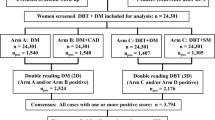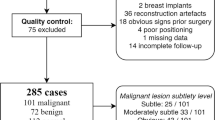Abstract
Objectives
To compare the diagnostic performance and interpretation time of digital breast tomosynthesis (DBT) for both novice and experienced readers with and without using a computer-aided detection (CAD) system for concurrent read.
Methods
CAD system was developed for concurrent read in DBT interpretation. In this observer performance study, we used an enriched sample of 100 DBT cases including 70 with and 30 without breast cancers. Image interpretation was performed by four radiologists with different experience levels (two experienced and two novice). Each reader completed two reading sessions (at a minimum 2-month interval), once with and once without CAD. Three different rating scales were used to record each reader’s interpretation. Reader performance with and without CAD was reported and compared for each radiologist. Reading time for each case was also recorded.
Results
Average area under the receiver operating characteristic curve values for BI-RADS scale on using CAD were 0.778 and 0.776 without using CAD, demonstrating no statistically significant differences. Results were consistent when the probability of malignancy and percentage probability of malignancy scales were used. Reading times per case were 72.07 s and 62.03 s (SD, 37.54 s vs 34.38 s) without and with CAD, respectively. The average difference in reading time on using CAD was a statistically significant decrease of 10.04 ± 1.85 s, providing 14% decrease in time. The time-reducing effect was consistently observed in both novice and experienced readers.
Conclusion
DBT combined with CAD reduced interpretation time without diagnostic performance loss to novice and experienced readers.
Key Points
• The use of a concurrent DBT-CAD system shortened interpretation time.
• The shortened interpretation time with DBT-CAD did not come at a cost to diagnostic performance to novice or experienced readers.
• The concurrent DBT-CAD system improved the efficiency of DBT interpretation.



Similar content being viewed by others
Abbreviations
- CAD:
-
Computer-aided detection
- DBT:
-
Digital breast tomosynthesis
- FFDM:
-
Full-field digital mammography
References
Tabár L, Vitak B, Chen HH, Yen MF, Duffy SW, Smith RA (2001) Beyond randomized controlled trials: organized mammographic screening substantially reduces breast carcinoma mortality. Cancer 91:1724–1731
Independent UK Panel on Breast Cancer Screening (2012) The benefits and harms of breast cancer screening: an independent review. Lancet 380:1778–1786
Boyd NF, Guo H, Martin LJ et al (2007) Mammographic density and the risk and detection of breast cancer. N Engl J Med 356:227–236
Harvey JA, Bovbjerg VE (2004) Quantitative assessment of mammographic breast density: relationship with breast cancer risk. Radiology 230:29–41
Kolb TM, Lichy J, Newhouse JH (2002) Comparison of the performance of screening mammography, physical examination, and breast US and evaluation of factors that influence them: an analysis of 27,825 patient evaluations. Radiology 225:165–175
Chiu SY, Duffy S, Yen AM, Tabar L, Smith RA, Chen HH (2010) Effect of baseline breast density on breast cancer incidence, stage, mortality, and screening parameters: 25-year follow-up of a Swedish mammographic screening. Cancer Epidemiol Biomarkers Prev 19:1219–1228
Kerlikowske K, Grady D, Barclay J, Sickles EA, Ernster V (1996) Effect of age, breast density, and family history on the sensitivity of first screening mammography. JAMA 276:33–38
Skaane P, Bandos AI, Gullien R et al (2013) Prospective trial comparing full-field digital mammography (FFDM) versus combined FFDM and tomosynthesis in a population-based screening programme using independent double reading with arbitration. Eur Radiol 23:2061–2071
Skaane P, Bandos AI, Gullien R et al (2013) Comparison of digital mammography alone and digital mammography plus tomosynthesis in a population-based screening program. Radiology 267:47–56
Ciatto S, Houssami N, Bernardi D et al (2013) Integration of 3D digital mammography with tomosynthesis for population breast-cancer screening (STORM): a prospective comparison study. Lancet Oncol 14:583–589
Lång K, Andersson I, Rosso A, Tingberg A, Timberg P, Zackrisson S (2016) Performance of one-view breast tomosynthesis as a stand-alone breast cancer screening modality: results from the Malmö Breast Tomosynthesis Screening Trial, a population-based study. Eur Radiol 26:184–190
Dang PA, Freer PE, Humphrey KL, Halpern EF, Rafferty EA (2014) Addition of tomosynthesis to conventional digital mammography: effect on image interpretation time of screening examinations. Radiology 270:49–56
Benedikt RA, Boatsman JE, Swann CA, Kirkpatrick AD, Toledano AY (2018) Concurrent computer-aided detection improves reading time of digital breast tomosynthesis and maintains interpretation performance in a multireader multicase study. AJR Am J Roentgenol 210:685–694
Balleyguier C, Arfi-Rouche J, Levy L et al (2017) Improving digital breast tomosynthesis reading time: a pilot multi-reader, multi-case study using concurrent computer-aided detection (CAD). Eur J Radiol 97:83–89
Duda RO, Hart PE (1972) Use of the Hough transformation to detect lines and curves in pictures. Commun ACM 15:11–15
Ballard DH (1981) Generalizing the Hough transform to detect arbitrary shapes. Pattern Recogn 13:111–122
He K, Zhang X, Ren S, Sun J (2016) Deep residual learning for image recognition. Proceedings of the IEEE conference on computer vision and pattern recognition, p 770–778
Jeong JW, Chae SH, Cho YL et al (2017) A deep convolutional neural network based false positive reduction in mass detection algorithm on digital breast tomosynthesis images. Int J CARS 12(Suppl 1):S273
Choi WJ, Kim HH, Lee SY et al (2016) A comparison between digital breast tomosynthesis and full-field digital mammography for the detection of breast cancers. Breast Cancer 23:886–892
Chae EY, Kim HH, Cha JH, Shin HJ, Choi WJ (2016) Detection and characterization of breast lesions in a selective diagnostic population: diagnostic accuracy study for comparison between one-view digital breast tomosynthesis and two-view full-field digital mammography. Br J Radiol 89:20150743
Gur D, Abrams GS, Chough DM et al (2009) Digital breast tomosynthesis: observer performance study. AJR Am J Roentgenol 193:586–591
Poplack SP, Tosteson TD, Kogel CA, Nagy HM (2007) Digital breast tomosynthesis: initial experience in 98 women with abnormal digital screening mammography. AJR Am J Roentgenol 189:616–623
Vedantham S, Karellas A, Vijayaraghavan GR, Kopans DB (2015) Digital breast tomosynthesis: state of the art. Radiology 277:663–684
Rafferty EA, Park JM, Philpotts LE et al (2013) Assessing radiologist performance using combined digital mammography and breast tomosynthesis compared with digital mammography alone: results of a multicenter, multireader trial. Radiology 266:104–113
Hooley RJ, Durand MA, Philpotts LE (2017) Advances in digital breast tomosynthesis. AJR Am J Roentgenol 208:256–266
McCarthy AM, Kontos D, Synnestvedt M et al (2014) Screening outcomes following implementation of digital breast tomosynthesis in a general-population screening program. J Natl Cancer Inst 106(11). https://doi.org/10.1093/jnci/dju316
Tucker L, Gilbert FJ, Astley SM et al (2017) Does reader performance with digital breast tomosynthesis vary according to experience with two-dimensional mammography? Radiology 283:371–380
Funding
This study has received funding by the R&D Convergence Program (Grant Number: CAP-13-3-KERI) of the National Research Council of Science & Technology (NST) of the Republic of Korea.
Author information
Authors and Affiliations
Corresponding author
Ethics declarations
Guarantor
The scientific guarantor of this publication is Hak Hee Kim.
Conflict of interest
The authors of this manuscript declare no relationships with any companies, whose products or services may be related to the subject matter of the article.
Statistics and biometry
Mingyu Han kindly provided statistical advice for this manuscript.
Informed consent
Written informed consent was waived by the Institutional Review Board.
Ethical approval
Institutional Review Board approval was obtained.
Methodology
• retrospective
• experimental
• performed at one institution
Rights and permissions
About this article
Cite this article
Chae, E.Y., Kim, H.H., Jeong, Jw. et al. Decrease in interpretation time for both novice and experienced readers using a concurrent computer-aided detection system for digital breast tomosynthesis. Eur Radiol 29, 2518–2525 (2019). https://doi.org/10.1007/s00330-018-5886-0
Received:
Accepted:
Published:
Issue Date:
DOI: https://doi.org/10.1007/s00330-018-5886-0




